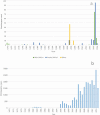Monkeypox re-emergence in Africa: a call to expand the concept and practice of One Health
- PMID: 30625020
- PMCID: PMC6438170
- DOI: 10.1080/14787210.2019.1567330
Monkeypox re-emergence in Africa: a call to expand the concept and practice of One Health
Abstract
Monkeypox is a re-emerging viral zoonosis that occurs naturally in heavily forested regions of West and Central Africa. Inter-human transmission of monkeypox virus, although limited, drives outbreaks, particularly in household and health-care settings. But the available evidence suggests that without repeated zoonotic introductions, human infections would eventually cease to occur. Therefore, interrupting virus transmission from animals to humans is key to combating this disease. Areas covered: Herein we review laboratory and field studies examining the susceptibility of various animal taxa to monkeypox virus infection, and note the competence of various species to serve as reservoirs or transmission hosts. In addition, we discuss early socio-ecologic theories of monkeypox virus transmission in rural settings and review current modes of ecologic investigation - including ecologic niche modeling, and ecologic sampling - in light of their potential to identify specific animal species and features of the environment that are associated with heightened risk for human disease. Expert opinion: The role of disease ecology and scientific research in ongoing disease prevention efforts should be reinforced, particularly for wildlife-associated zoonoses such as monkeypox. Such efforts alongside those aimed at nurturing 'One Health' collaborations may ultimately hold the greatest promise for reducing human infections with this pathogen.
Keywords: Monkeypox; One Health; orthopoxvirus; zoonosis; .
Figures



References
-
- von Magnus P, Andersen E, Petersen K, et al. A pox-like disease in Cynomolgus monkeys. Acta Pathol Microbiol Scand. 1959;46:156–176.
-
- Arita I, Henderson DA.. Smallpox and monkeypox in non-human primates. Bull World Health Organ. 1968;39:277–283. - PMC - PubMed
-
• Paper summarizes findings from the earliest investigations of monkeypox virus outbreaks in captive animals and describes sporadic, naturally-occurring outbreaks of smallpox among wild primates.
-
- Breman JG. Monkeypox: an emerging infection for humans? In: Scheld WM, Craig WA, Hughes JM, editors. Emerging infections 4. Washington (DC): ASM Press; 2000. p. 45–67.
Publication types
MeSH terms
Grants and funding
LinkOut - more resources
Full Text Sources
Medical
Miscellaneous
